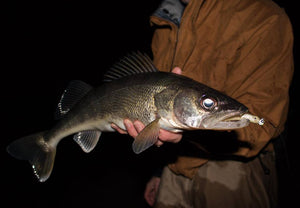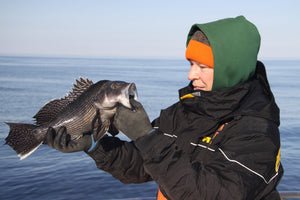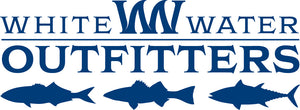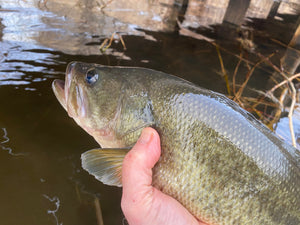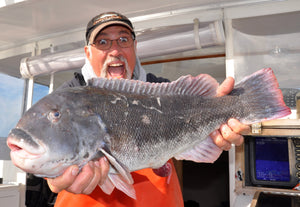Warm Up To Spring Carp

There was a time when some Long Island freshwater fans looked at carp with a degree of disdain. Many believed they increased the turbidity of local lakes and ponds, ruined the spawning nests of bass and panfish, and outcompeted native fish for food, cover and space.
While such misdeeds may be true of more recently introduced invasive species like silver carp, grass carp and black carp, which in some instances are wreaking havoc in other parts of the country, the common carp swimming in Long Island waters for over a century actually have little if any negative impact on fish populations with which they mingle – and their eggs serve as fodder for panfish while their juvenile young can be meals for predator and opportunistic scavenger species.

Carp grow big in Long Island lakes and ponds. They also like to cruise close to shore in the early spring. Photo by OutdoorTom.Com
All that said, it’s clear local anglers have changed their tune in recent years on these huge members of the minnow family (your read that right – carp are minnows!) Indeed, carp fishing is actually a respectable pastime now. After all, they can stretch over three feet in length, top 30 pounds, and put up a brutish fight on medium- to light-heavy-class spinning gear. They are somewhat line shy, certainly noise shy, and much smarter than you might think if you’ve never matched wits against them.
Spring Is King
If the thought of hooking into Long Island’s largest freshwater fish species has had you thinking about taking the plunge, now’s the time for action. For one thing, most sweetwater fans at this point in the season are focused on trout or catch and release bass so there isn’t much competition for these beasts. Weed growth is also at a minimum during early spring, making it easier to get your baits down to the bottom and into the primary strike zone during March, April and early May. Additionally, with waters still cool, all that’s needed is a little bit of sunshine and a couple degree rise in water temperature to get these fish moving about and fired-up to inhale a few snacks.
Of course, you’ll want to do a little scouting before making those first casts. To that end, know that spring carp often hold in deeper water and slight depressions that border the edge of small-and medium-sized flats. As the water warms during the day, they’ll slide up into the shallows – often right next to shore. If approaching the water on foot, tread lightly and you might get close enough to spy a fish or two before they spy you. If in a kayak or boat, glide quietly through any potential hot spots like cove mouths or open flats. In each of these areas, note any huge swirls or wakes indicating big fish moving off. Should you spook a couple nice ones, back off, silently move ahead of the wakes, and allow the fish to come to you. Once spooked, they may or may not bite, but at least you’ll know where they are for a fresh approach to within casting distance at the same time of the morning or evening over the next couple of days.
What’s For Dinner?
Baiting up is the easy part of carp fishing. Although there are plenty of recipes for making special corn meal-based carp baits known as “boilies,” all you really need are some bread balls or corn kernels.

Corn is a great carp bait. String several kernels up a hook, cast out and keep your line still to optimize success. Photo by OutdoorTom.Com
Bread balls are nothing more than a piece of white bread, rolled into a tight ball ranging in size from a quarter to a half-dollar coin. You can slide this onto a size 1 or 2 beak style bait-holder hook so the gap and shank are fully covered but the barb and point are just slightly exposed. If using corn kernels, simply slide several over the point and up the shaft of the hook until all but the point and barb are covered.
Keep It Simple
There are a ton of specialized rigs designed for carp fishing, but you’ll do best to keep things simple. Start with a sturdy, 10- to 15-pound-class spinning setup along the lines of our Daiwa BG 3000 Combo or St. Croix X-Trek CTC Fishing System (CTCS7OMF-C), and tie the hook directly to the end of the main line without a leader, snap, swivel or added weight (use a 12- to 15-pound fluorocarbon leader if fishing with braided line.) This will allow corn kernels or bread ball baits to gently sink on their own and, hopefully, settle atop the weed roots where they will be easy for your targets to find.
Most of the time you'll fish blind for carp, casting to spots where you've caught or scouted the fish before. Some days, however, even in March and April, these fish will break the surface with their backs and tails as they tip forward and downward to root around in the weeds. Watch these breaks carefully to discern which direction the fish are working and drop a cast ten or 15 yards ahead of the pack so the carp will cruise toward your bait without being spooked by the splash. Time it right and you are just minutes away from a hefty hook-up.
There are plenty of lakes and ponds across Long Island that feature significant carp populations including Hempstead Lake, Wantagh Mill Pond, Massapequa Reservoir, Lake Ronkonkoma, Peconic River, Belmont Lake, Argyle Lake, several Town of Southampton lakes (open to Town of Southampton residents only), and Fort Pond in Montauk.
As the spring season warms up, you’ll find these big-bodied cruisers growing increasingly active until the weeds and heat of early summer finally dull the bite. Get out now, give ’em a try, and be sure to practice catch and release - because the only thing more thrilling than seeing one of these big tanks at the end of your line is watching it swim off to fight another day.
- Bryce Poyer


